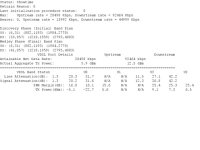I can add my story to the tale of woes experienced with the DSL-AC68U.
Zen Internet via the BT Openreach modem to ASA 5505, connected for weeks without any drop outs.
Plug in the DSL-AC68U and after the initial sync giving me same speed within a couple of days I`ve lost 10mbps download speed / synch speed.
I`ve Tried the following.
- Set "Stability Adjustment (VDSL)" to 9 dB.
- Set "Rx AGC GAIN Adjustment (VDSL)" to Stable.
- updating firmware and even put the beta firmware as recomended by Paul Lee@ASUS.
-ESNP - Enhanced Sudden Noise Protection (VDSL). Set to Stable to enable it, and with following settings configured.
- Set "Stability Adjustment (VDSL)" to 12 dB.
- Set "Rx AGC GAIN Adjustment (VDSL)" to Stable.
It was after setting the ESNP where I noticed I had changed from fastpath to Interleaved, my max attainable download dropped to 40mbps from 60mbps, my ping increased to sites and my son started complaining about Fifa 15 being laggy online...
I`ve gone back to the BT openreach box on the wall and enabled dual wan mode until this can get sorted, or I lose patience and contact Amazon and tell them that the box is not fit for purpose.
Zen Internet via the BT Openreach modem to ASA 5505, connected for weeks without any drop outs.
Plug in the DSL-AC68U and after the initial sync giving me same speed within a couple of days I`ve lost 10mbps download speed / synch speed.
I`ve Tried the following.
- Set "Stability Adjustment (VDSL)" to 9 dB.
- Set "Rx AGC GAIN Adjustment (VDSL)" to Stable.
- updating firmware and even put the beta firmware as recomended by Paul Lee@ASUS.
-ESNP - Enhanced Sudden Noise Protection (VDSL). Set to Stable to enable it, and with following settings configured.
- Set "Stability Adjustment (VDSL)" to 12 dB.
- Set "Rx AGC GAIN Adjustment (VDSL)" to Stable.
It was after setting the ESNP where I noticed I had changed from fastpath to Interleaved, my max attainable download dropped to 40mbps from 60mbps, my ping increased to sites and my son started complaining about Fifa 15 being laggy online...
I`ve gone back to the BT openreach box on the wall and enabled dual wan mode until this can get sorted, or I lose patience and contact Amazon and tell them that the box is not fit for purpose.
Last edited:





